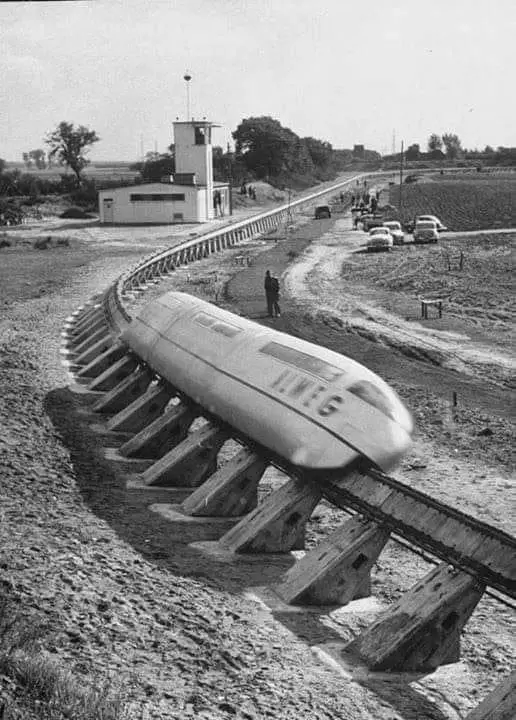The ALWEG Monorail: A Revolutionary Leap in Urban Transportation
The ALWEG monorail, implemented in Cologne, Germany, in 1952, represents a groundbreaking milestone in the history of urban transportation. Designed by the ALWEG company, this innovative system embodied the forward-thinking spirit of post-war engineering and addressed key challenges in urban mobility. By integrating a single-track structure with a suspension system, the ALWEG monorail not only revolutionized transportation in its time but also set the stage for future advancements in mass transit systems.

Historical Context: Germany in the Post-War Era
The 1950s were a transformative period for Germany. Cities across the country were rebuilding after the devastation of World War II, and infrastructure modernization was a key focus. With increasing urbanization and the proliferation of automobiles, city planners faced mounting pressure to develop efficient transportation solutions that minimized land use and traffic congestion.
The ALWEG monorail emerged as a response to these challenges. Named after its founder, Axel Lennart Wenner-Gren, the ALWEG company sought to create a transit system that combined efficiency, innovation, and minimal environmental impact.
The ALWEG Monorail’s Pioneering Design
The defining feature of the ALWEG monorail is its single-track structure, which supports the train using an overhead beam. This innovative design enabled several key advantages:
- Space Efficiency
Unlike traditional rail systems, the elevated track eliminated the need for extensive ground space. This allowed cities like Cologne to preserve existing roads and infrastructure, avoiding major disruptions. - Seamless Integration with Urban Areas
The elevated suspension system allowed the monorail to bypass traffic congestion entirely. By traveling above the city streets, it provided an uninterrupted and rapid mode of transportation for commuters. - Technological Innovation
The ALWEG monorail incorporated advanced engineering principles for its time. Its suspension system was designed to distribute weight evenly along the track, reducing wear and tear while enhancing stability.
The Impact on Urban Transportation
The introduction of the ALWEG monorail in Cologne marked a significant shift in urban mobility. The system not only provided a practical solution to increasing commuter demands but also demonstrated the potential of monorail technology for cities worldwide. Its implementation inspired similar projects in other parts of the world, including the Seattle Monorail in the United States and the Tokyo Monorail in Japan.
In addition, the ALWEG monorail became a symbol of innovation and progress during the mid-20th century. It highlighted the importance of rethinking transportation systems to accommodate growing urban populations while minimizing environmental and spatial impact.
Legacy and Influence
The ALWEG monorail’s influence extends far beyond its initial deployment in Cologne. Its design principles have been incorporated into modern urban transportation systems worldwide. Today, cities like Kuala Lumpur, Las Vegas, and São Paulo continue to use monorails as a reliable and space-efficient means of transit.
The ALWEG company itself played a pivotal role in the global expansion of monorail technology. For example:
- Seattle Center Monorail (1962): Built for the World’s Fair, this monorail is still operational and serves as a vital part of Seattle’s public transportation network.
- Tokyo Monorail (1964): Connecting Haneda Airport to central Tokyo, this system is among the busiest monorails in the world.
Lessons for Modern Transportation
The ALWEG monorail underscores the importance of forward-thinking transportation planning. As cities today grapple with issues like traffic congestion, environmental sustainability, and limited space, the principles behind the ALWEG design remain highly relevant. Elevated transit systems, like monorails, continue to offer practical solutions by:
- Reducing urban sprawl.
- Lowering carbon emissions through electrified systems.
- Enhancing connectivity without compromising land usage.
Conclusion
The ALWEG monorail stands as a testament to the ingenuity and vision of mid-20th-century engineering. From its pioneering single-track design to its long-lasting influence on global transportation, it remains a landmark achievement in urban mobility. As cities evolve and adapt to modern challenges, the legacy of the ALWEG monorail serves as a reminder of the transformative power of innovation in shaping the future of urban transportation.








Post Comment